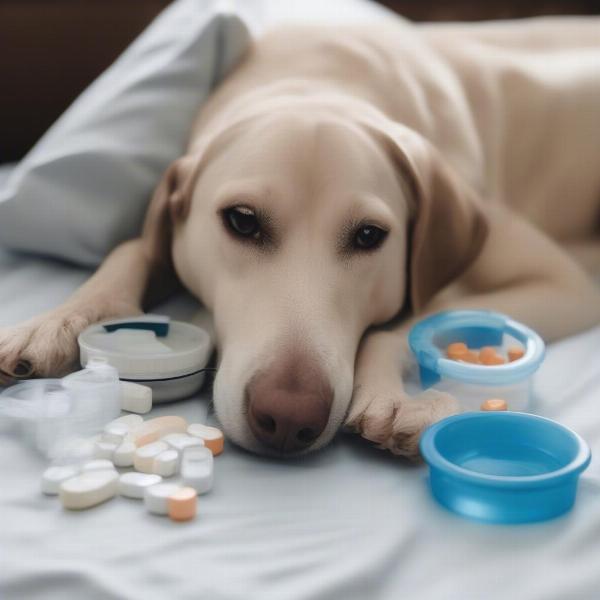Recovering from a dog leg amputation can be a challenging time for both you and your furry friend. Understanding the process, potential complications, and how to provide optimal care can significantly improve your dog’s comfort and speed up their recovery. This guide covers everything you need to know about dog leg amputation recovery, from preparing your home to managing pain and ensuring long-term well-being.
After surgery, your dog will need a quiet, comfortable, and safe space to recover. Remove any potential hazards like slippery rugs or furniture with sharp corners. Provide a soft, supportive bed and ensure easy access to food and water. Pain management is crucial in the initial stages. Your vet will prescribe medication to help manage discomfort. Follow their instructions carefully and monitor your dog for any signs of pain or discomfort. Physical therapy plays a vital role in helping your dog adjust to life on three legs. Gentle exercises, prescribed by your veterinarian or a certified canine rehabilitation therapist, can strengthen remaining muscles and improve balance.
Preparing Your Home for a Tripawd
Creating a safe and supportive environment is essential for a smooth dog leg amputation recovery. Consider these modifications:
- Flooring: Slippery surfaces can make it difficult for your dog to navigate. Use non-slip mats or rugs, especially on hardwood or tile floors. Carpet runners can also provide traction and stability.
- Ramps: Install ramps to help your dog access furniture, cars, or other elevated areas. This reduces strain on their remaining limbs.
- Elevated Food and Water Bowls: Raising food and water bowls can make it easier for your dog to eat and drink without straining their neck.
- Harness: A well-fitting harness can provide better support and control than a collar, particularly when helping your dog up or down stairs.
Managing Pain and Discomfort After Surgery
Pain management is a critical aspect of dog leg amputation recovery. Here’s what you need to know:
- Medication: Your vet will prescribe pain relievers and anti-inflammatory medications. Administer them as directed and monitor for any adverse reactions.
- Signs of Pain: Observe your dog for signs of pain, such as whimpering, restlessness, decreased appetite, or reluctance to move. Contact your vet if you notice any changes.
- Alternative Therapies: Discuss options like acupuncture, laser therapy, or massage with your veterinarian. These can complement traditional pain management methods.
 Managing Pain After Dog Leg Amputation
Managing Pain After Dog Leg Amputation
Physical Therapy and Rehabilitation
Physical therapy is crucial for regaining strength, balance, and mobility after dog leg amputation.
- Professional Guidance: Consult with a certified canine rehabilitation therapist for a tailored exercise plan.
- Gentle Exercises: Start with short, low-impact activities like leash walks on level ground. Gradually increase the duration and intensity as your dog progresses.
- Hydrotherapy: Swimming or underwater treadmill therapy can provide a low-impact workout and build muscle strength.
- Assistive Devices: In some cases, prosthetics or orthotics may be beneficial. Consult with your vet to determine if these are suitable for your dog.
Long-Term Care for Tripawd Dogs
While your dog will likely adapt remarkably well to life on three legs, ongoing care is essential. Maintain a healthy weight to minimize stress on their remaining limbs. Regular vet checkups are important to monitor for any complications. Continue providing a supportive and enriching environment.
Conclusion
Dog leg amputation recovery requires patience, dedication, and a commitment to providing the best possible care. By following your veterinarian’s instructions, creating a safe environment, and implementing a comprehensive rehabilitation plan, you can help your dog live a happy, healthy, and fulfilling life on three legs. Remember, a tripawd dog can still enjoy a high quality of life with your love and support.
FAQ
- How long does it take for a dog to recover from leg amputation? Most dogs recover within 4-6 weeks, but full recovery can take several months.
- What are the potential complications of dog leg amputation? Complications are rare but can include infection, nerve damage, and phantom limb pain.
- Can my dog still enjoy walks and other activities after amputation? Absolutely! With proper rehabilitation, most dogs can return to many of their favorite activities.
- What kind of food should I feed my dog after amputation? Maintain a healthy diet to manage weight and support healing.
- How can I make my home safer for my tripawd dog? Use non-slip mats, ramps, and elevated food and water bowls.
- How can I tell if my dog is in pain after surgery? Watch for signs like whimpering, restlessness, or decreased appetite.
- Where can I find a certified canine rehabilitation therapist? Ask your vet for recommendations.
ILM Dog is a leading international online resource dedicated to providing dog owners worldwide with expert advice and practical guidance on all aspects of dog care. From breed selection and puppy care to senior dog health and training tips, we offer evidence-based information to help you give your furry companion the best possible life. We offer expert advice on Dog Breeds and Selection, Health and Medical Care, Training and Behavior, Nutrition and Feeding, Grooming and Hygiene, and Products and Accessories. For any assistance, contact us at [email protected] or call us at +44 20-3965-8624. ILM Dog is your trusted partner in responsible dog ownership.